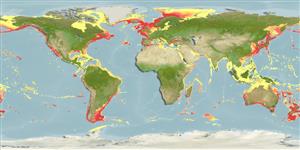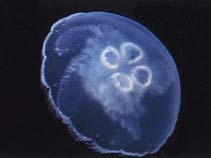Aurelia aurita (Linnaeus, 1758)
Moon jelly| Native range | All suitable habitat | Point map | Year 2050 |

|
| This map was computer-generated and has not yet been reviewed. |
| Aurelia aurita AquaMaps Data sources: GBIF OBIS |
Classification / Names Populärnamn | synonymer | CoL | ITIS | WoRMS
Scyphozoa | Semaeostomeae | Ulmaridae | Aureliinae
Environment: milieu / climate zone / djupintervall / distribution range Ekologi
Pelagiska; brackvatten; djupintervall 0 - 1250 m (Ref. 116114). Subtropical; 78°N - 55°S, 180°W - 180°E
Distribution Länder | FAO områden | Ekosystem | Förekomster | Utplanteringar
Circumglobal. This species is widespread in all the seas of the sphere, from the equator to the poles. Subtropical to polar.
Length at first maturity / Size / Weight / Age
Könsmognad: Lm ?, range 2 - 31 cm Max length : 50.0 cm WD hane/ej könsbestämd; (Ref. 2376)
Short description Morfologi
Life cycle and mating behavior Könsmognad | Reproduktion | Lek | Eggs | Fecundity | Larvae
Main reference
referenser | Koordinator | Medarbetare
Wrobel, D. and C.E. Mills 1998 Pacific coasts pelagic invertebrates: a guide to the common gelatinous animals. Sea Challengers and the Monterey Bay Aquarium, Monterey, California.112 p. (Ref. 2376)
IUCN Red List Status
(Ref. 130435: Version 2025-1)
CITES status (Ref. 108899)
CMS (Ref. 116361)
Threat to humans
Human uses
Fiskeri: kommersiell
| FishSource |
Verktyg
Ytterligare information
Max. ages / sizes
Length-weight rel.
Length-length rel.
Length-frequencies
Mass conversion
Abundans
Internet-källor
BHL | BOLD Systems | CISTI | DiscoverLife | FAO(Publication : search) | Fishipedia | GenBank (genome, nucleotide) | GloBI | Gomexsi | Google Books | Google Scholar | Google | PubMed | Tree of Life | Wikipedia (Go, sök) | Zoological Record



